The Rushden Echo, 21st February 1964, transcribed by Gill Hollis
Rushden – A Good Place to Work and Live
A house and job are two of the most important things in life and often the most difficult to come by, but here at Rushden there are houses readily available and the choice of employment in a variety of industries is open to newcomers to the town.
Times, it appears, have changed drastically since about this time last year, when the town was at its lowest ebb for many years, with a depression in the footwear industry. Then the unemployment figures were the highest they had been for a long time and things looked very unpromising for a lot of townspeople.
Throughout the past year the boot and shoe industry has picked up again steadily. At present it is enjoying a minor boom meeting the demands of modern fashions. There are now jobs in plenty in the town’s different industries.
New homes are springing up everywhere. There are at least five major housing estates either planned or in various stages of construction.
First of all there is the council’s development scheme at Kilburn Place, work on which is now in full swing.
Private estates are going up in several different parts of Rushden and the biggest of all, a 200-house estate off St. Margaret’s Avenue, has now been approved.
A spokesman for a local estate agent said that new houses were now selling “pretty well” after a lull around Christmas. The people buying them were a complete cross-section of the community and while the majority were local people about 15 to 20 per cent were newcomers to the town.
The prospects of employment are quite good in the leather, footwear and tanning industries, said Mr. D. Stratton, manager of the Employment Exchange. There were demands for men in most other sections of industry including transport, the iron mines, distributive trades and the professions.
“We are very fortunate in that we have a wide scope of employment for newcomers,” he said.
Someone wishing to settle at Rushden but without any recognised skill for local industry need not be deterred because there are industries willing to take on unskilled men and train them in new methods.
With the prospect of a rise in Rushden’s population the “Echo” asked Mr. John Coleman, president of Rushden and Higham Ferrers and District Chamber of Trade, about shopping facilities, and whether he thought there was any need to improve them.
He said he did not think that in view of the number of newcomers to the town and the current building programmes there was any call for a change in the existing shopping facilities. “I think the shops are adequate to cater for all general needs,” he said.
There would have to be a greater influx of population before any alterations to the facilities was necessary.
|
The Rushden Echo, 5th June 1964, transcribed by Jim Hollis
No Progress Till Boundary Report
Until the findings of the Boundary Commission are made known Rushden’s future, the structure of its industry, housing schemes, road works, town centre and traffic system will not progress.
This was the view expressed by Mr. Alan Allebone, Chairman of the urban council, in the first of a series of face to face interviews designed to introduce the views, aims and opinions of Rushden and Higham Ferrers councillors.
Result
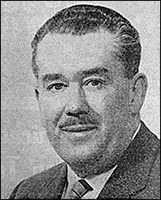 With so much depending on the result of the boundary commission, Mr. Allebone was asked how this affected the present state of things. He answered: “We cannot plan sufficiently for the future until we know the extent to which Rushden will develop. The council would wish to know whether land between the Court Estate and the town was to be developed for residential and/or industrial purposes, so that the services could be properly planned. With so much depending on the result of the boundary commission, Mr. Allebone was asked how this affected the present state of things. He answered: “We cannot plan sufficiently for the future until we know the extent to which Rushden will develop. The council would wish to know whether land between the Court Estate and the town was to be developed for residential and/or industrial purposes, so that the services could be properly planned.
The proposed incinerator, about which he felt strongly, was also tied up with planning.
Mr. Allebone believes that an incinerator is the ultimate correct method of dealing with the town’s refuse, but until the development is determined, so that the incinerator could be sited outside the residential area, he feels that Rushden should not go ahead with the project costing £90,000.
What did he think about amalgamation? “There must ultimately be amalgamation between Rushden and Higham or Higham and Rushden,” he said.
About the possible problems involved in such a move he maintained: “I do not think the smaller issues should cloud the main issue.”
One big advantage would be the easing of the staffing question and another streamlining of services.
Did he think that Rushden’s roads were good?
Mr. Allebone agreed that much could be done to them but there were certain drawbacks. Loans are obtainable but interest has to be paid, and the amount that can be done is related to the rate demand.
Turning to the possible influx of overspill, he felt that any new industry coming to the town should not be connected with the shoe trade.
A shoe manufacturer himself Mr. Allebone thought that they should try to get away from the shoe trade. What was needed was light industry for men.
The closing of Rushden station was a tragedy, but he did not see why Irchester station could not have been developed to serve Rushden.
The sterilised land at Knuston had, however, probably been the reason why this had happened, and also why the town had not expanded more towards the west.
An idea with which Mr. Allebone did not agree was that of Rushden having a twin town on the Continent. He could see no merit at all in the idea. Perhaps the situation might be different if Britain entered the Common Market.
|
The Rushden Echo, 12th June 1964, transcribed by Jim Hollis
Mrs. Shrive speaks out
More people must be attracted to Rushden, and the town must be developed – and redeveloped – with this in mind.
The future of the town is uppermost in the mind of Mrs. Doris E. Shrive, vice-chairman of Rushden Urban Council. Unhesitatingly attacking any steps which she feels would be a retrograde step in obtaining a “nice Rushden,” she is acutely aware of the town’s shortcoming.
Aware, too, of its assets, Mrs. Shrive spoke of Hall Park. “It is a wonderful park, with a wonderful tea room there,” she said. “But I would like to see it developed a bit more.
“Something like Wicksteed Park at Kettering,” Mrs. Shrive agreed, would attract the people to the town. The beautiful flower beds would remain though. “You have to speculate to accumulate,” she added.
Mrs. Shrive spoke out against the plan to put a roof on the swimming pool, as she has done on previous occasions.
“If we have a covered pool it should be started from scratch. Of course, it would have to be undertaken by a voluntary body so as not to be a burden on the rates. But Rushden people are most generous when they want something. At present the pool is not adequate to warrant a roof.”
On the question of shopping facilities she said: “I would like to see a shopping centre that acts like a magnet to the surrounding towns and attracts people to it,” she added.
One criticism she had heard of the town was that all the shops were in one street.
Would she agree that Rushden was a “one horse town” then? “No, I would not like to say that,” she said, adding that she had been born here.
Traffic problems is another field of interest for Mrs. Shrive, as she also serves on the Road Safety Committee.
One of her great concerns is the fact that heavy vehicles use the High Street instead of keeping to the sign posted diversion.
She supported a plan publicised by the “Echo” recently for Duck Street to be used as a north-bound by-pass for the High street.
Roads
With redevelopment she would like to see rear entries to all shops, eliminating parking in the street for loading and unloading. But in general, the state of the roads left a lot to be desired, she said.
The future of the town is closely linked with that of Higham Ferrers, she feels. Amalgamation was inevitable, but which would amalgamate with which she would not like to guess, she added.
With a possible jump in population of 30,000 through overspill, Mrs. Shrive sounds a note of caution about employment. New industry, other than boots and shoes, should be brought with overspill and not try to fit them into existing industries.
|
The Rushden Echo, 26th February 1965, transcribed by Jim Hollis
High Street Shopping - Precinct Plan Ban
The Ministry of Transport has cracked down on a planning application which could have radically altered the face of Rushden High Street. In fact it could have completely changed local housewives’ shopping habits.
The application was for 16 new shops and a supermarket, complete with pedestrian precinct, car parking facilities and service roads. The whole of this extensive development was proposed off the north end of High Street, between Station Road and Duck Street.
At Wednesday’s Urban Council meeting it was reported that the application had been refused on the recommendation of the Planning Officer.
The objections listed were: The town centre of Rushden was being studied to assess the needs, if any, for further shopping in the town. Until this had been completed it would be premature to permit a substantial block of new shops on the periphery of the present town centre shopping area.
Inadequate
The following objections were made by direction of the Ministry of Transport.
Part of the development was within the area which would be required for the ultimate realignment of the trunk road.
Inadequate facilities for loading and unloading at the rear of the proposed development.
Inadequate parking facilities.
Inadequate facilities for turning vehicles.
Ultimate satisfactory redevelopment of property adjacent to Station Road appears to be prejudiced.
Traffic Flow
The proposed development would give rise to conditions which would be detrimental to the safety and free flow of traffic on the trunk road.
The plan of the proposed development is taken from the preliminary particulars issued by Wilson and Partners, Rushden, on behalf of Calgory and Edmonton Land Corporation Ltd.
The corporation bought the site by private treaty after it had been offered in two lots at a public auction in April last year. At the auction the first lot was withdrawn at £29,000 and the second at £24,000.
Mrs. G. Penness a housewife and chairman of Rushden Mothers’ Club told the “Echo” that she was most disappointed to hear that the application had been refused.
She thought there was a need for a pedestrian precinct in Rushden’s shopping centre.
And she is not the only one. A spot check with shoppers in the High Street this week brought these comments:
Sorry
Mrs. E. L. Cave, Rushden: “I think that the council ought to provide more shopping facilities in the town, especially in that area.”
Mrs. J. Jackson, Higham Ferrers: “I come into Rushden to shop almost every day. I am sorry the application was turned down, as it would be a safe shopping area with no roads to cross, the more shops in the town the better.”
Mrs. Edna Short, Rushden: “I think it would attract people from outside the town. There is a trend for these sort of areas and it’s a pity Rushden cannot have one.”
Miss D. York, Rushden: “I would like more shops in that area, particularly clothing and furnishing stores.”
|
The Rushden Echo, 7th January 1966, transcribed by Jim Hollis
Construction of shopping precinct at Rushden is well under way
Construction of a new shopping precinct in High Street South, Rushden, is now well under way, as can be seen from the photograph (below right).
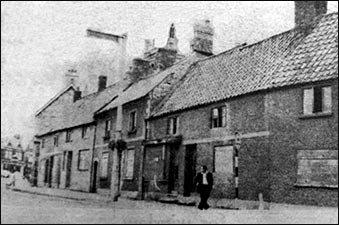 |
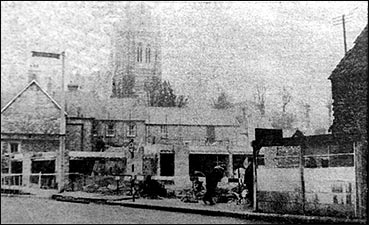 |
|
The row of cottages
|
The new Precint shops
|
Before work could start, empty cottages (above left) which had been boarded up had to be pulled down. The cottages and land were bought in October 1964, by the London based Bedford (Ford End) Property Co. Ltd.
Result
Last June the company was awaiting the result of a second revised planning application to the County Planning Authority for consideration by the Government as the area is off the main trunk road.
This second lot of plans was for eight shops around a central precinct, extending back to a depth of three shops.
|
The Rushden Echo, 17th June 1966, transcribed by Jim Hollis
New shopping precinct a white elephant?
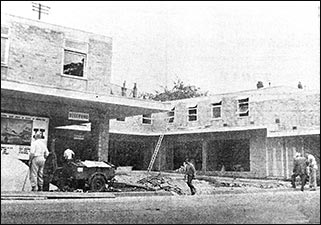 |
|
Shops
|
Fear that Rushden’s new shopping precinct in High Street South might become a “white elephant” is spreading through the town’s traders who believe the site is not well placed for business.
There are eight shops on the site and as yet only three of them have attracted traders. And all three are in a position to withdraw if they have second thoughts about the suitability of the shops situation.
The three businesses interested are a decorators, greengrocers and restaurant. The shops should be completed by the end of July and so it would appear that three interested businesses at this late stage is an unsatisfactory number.
The main agent for the shops is the Bedford firm, R. W. Stonebanks and Co. and their main sub-agent in Rushden is Amos Horsburgh and Co.
Unfinished
A spokesman for Horsburgh’s said local traders seem to think the site is too far off the High Street.
He added: “What we have got to do is attract outsiders to the shops.” He thought the present apprehension could be caused because the shops are not very presentable in their unfinished state and that when they are nearer completion traders may be more inclined to take them.
Mr. B. Thomas, president of the Rushden and Higham Ferrers Chamber of Trade, thought the site was definitely too far off the High Street.
He said: “The church almost certainly acts as a barrier and people coming into the town from the Bedford area get off the bus at the Lightstrung and go straight up Church Street to the High Street.”
Welcome
He did say that he would, of course, welcome more trade to the town as it would make Rushden a better shopping centre.
The “Echo” feels it would be a pity if the precinct became a “white elephant.” We have always supported further shopping amenities and feel it would be good for the town if the shopping area was not concentrated on the High Street.
Further shopping development is taking place in the town and more is proposed.
At the bottom of St. Mary’s Avenue three shops are being built and these should be completed by the end of next month. Two of these shops have traders interested in taking over the premises.
The proposed development is at the railway end of the High Street. It is planned to build a pedestrian shopping precinct here.
High Street – The Gourmets’ Paradise Lane
If Rushden High Street ever became a pedestrian precinct would it be necessary for shoppers to go out of the traffic-free area for their shopping.
This week we carried out a survey of shops and the facilities offered along the length of Rushden’s busy High Street and came up with the following facts:
There are more food shops in the High Street than other types; there are ten grocery shops, butchers and food stores serving the main street for almost its full length.
No Excuse
It has often been said that there are a lot of electrical shops in the High Street, but these come fourth on the list. Women’s and men’s outfitters including shops selling materials, fill the second and third type respectively.
So Rushden people have no excuse to be badly dressed, and just to keep our clothes spotless, the business men have provided us with four dry cleaning or laundry premises.
Not unnaturally Rushden has its fair share of shoe shops. There are five of these on the High Street, selling high class and the cheaper grade of shoes.
. . . And More
For the do-it-yourself man there are three paint and hardware stores on the High Street, and others just off the area.
There are sweet shops, stationers, newsagents, two restaurants, opticians and chemists, miscellaneous gift shops and jewellers, two fishmongers, seed merchants, a pet shop, a sports wear and equipment shop, five furniture shops and Woolworths.
If you like fruit, you will have no worry. There are five fruiterers also selling flowers, and one pure florist.
|
The Rushden Echo, 11th November 1966, transcribed by Jim Hollis
At Last the Roads are Finished
After more than twelve months, the roads on the Wymington Estate, at the top of St. Margarets Avenue, Rushden, are nearing completion and both the residents and workmen seem delighted to see the end in sight, for arguments have been raging ever since the work was started.
The builders, the various sub-contractors, the East Midlands Electricity Board, and other public services along with angry residents from the estate, have during this time somewhat trodden on each other’s feet.
The tenants of some of the roads in the area blamed the builders; in turn the builders blamed first the Rushden Urban Council, then the East Midlands Electricity Board.
The council in turn thought it was the responsibility of the sub-contractors who had been given the work by the builders.
Not Right
The main responsibility for making up the roads is in fact that of the sub-contractors. Farmiloe and McVie, but it is certainly not the right to condemn them for the delay, blame must be apportioned duly to all those who have been connected in some way with the estate.
Last June another figure entered the scene, Mr. Harry Howarth, MP for the Wellingborough Division. He carried out a roadside interview with residents of Abbots Way who, because they had to deal with the worst road conditions in the vicinity formed themselves into a small but determined pressure group.
He promised them immediate action on the site of the unmade roads. This following the fact that a month before he had received a petition which had stated that. “The appalling conditions over the last six months were no longer tolerable.”
The problem continued. Then about two months ago the Labour Party agent for Mr. Howarth, in Mr. Howarth’s absence, was told that all the roads on the estate would be completed by the end of November.
It seems certain that bar atrocious weather conditions or some major catastrophe this promise will be met.
There are a few roads which still have to have the top coat of tarmac put on them, but the only other roads not in this late stage of completion are Blackfriars and Priory, which they are concentrating on at the moment.
Mr. Bill Smith, in charge of the roads for Farmiloe and McVie, was rather bitter about the whole affair and said that if it had not been for all the hold ups and the bad weather the job should have taken about four months instead of nearly fourteen.
“This has probably been the lousiest job I have done since I began public works contracts,” he said and left it at that.
As for the residents affected, most of them were just pleased that at long last the roads have been laid and no longer are there the problem of ruining the car or damaging their babies’ prams.
|
The Rushden Echo, 30th June 1967, transcribed by Jim Hollis
Anger over plan for ‘shanty town’
Rushden Urban Council has come under fire for its decision to seek a compulsory purchase order for the six-acre garage and allotment site off Hayden Road.
Only one councillor spoke out against the decision at the last council meeting, but it is not popular among some of the people who own garages or cultivate land on the site.
At the moment the site is covered by numerous garages of various types, shapes and sizes, some well-constructed, others in a dilapidated condition. In between there are areas of cultivated and uncultivated ground.
The council wants the land for its future house building programme. They intend to construct old people’s houses, garages – to replace those they take over – and houses.
At this stage it is thought the houses will be used to accommodate people from the Southfields prefabricated estate, which is nearing the end of its useful life.
A spokesman for the council told the “Echo” that the land was owned by so many people it was almost impossible to attempt to negotiate with the owners individually.
Compensation
“That is why we have taken out a compulsory purchase order. But that does not mean we will not try to negotiate individually where possible,” he said.
“All owners will be compensated and we do plan to build garages to replace those already on the site.”
Mr. R. D. Gilhooley, the only councillor to speak out against the decision, said the council would have to be prepared to pay high compensation. In its present use it was showing a good return per acre.
He said there were some elderly people who had invested their nest eggs in garages to let to help them maintain their independence.
He was against having the site redeveloped because he thought there were better sites available in the area.
“There is a field at the end of Manning Street which is undeveloped,” he said.
Hidden
Some people have likened the rows of oddly shaped garages on the Hayden Road site to a “Shanty Town” and Mr. Gilhooley agreed that the site “did not look very nice,” but added, at least it was hidden from view.
“I’m mainly concerned with the people who are going to be dispossessed, rather than how the site looks,” he said.
Someone else – who has complained to the “Echo”, is Mr. Cliff Perkins, 134 Cromwell Road, who owns two plots – solely used for gardening – on the land which the council may purchase.
“It is impossible to compensate me for the pleasure I get from growing my own fresh vegetables and flowers, even if the council pay me for taking away my land,” said Mr. Perkins.
Mr. Perkins lives for his garden and it is a real source of pleasure to him.
“I have no back garden in which to grow anything, and if the plots I have are taken, where am I going to find another piece of land anywhere near my house?” he asked.
Mr. Perkins mentions four roads where there have been gardening plots in the past, but which the council have since claimed, and he wonders where, unless you have your own garden, can someone now do a little gardening for pleasure.
The pleasure is greatly reduced if you have to walk or cycle some miles to tend your plot, he claims.
|
The Rushden Echo, 13th January 1967, transcribed by Jim Hollis
Factory wants to move to Rushden
An application is being made to the Board of Trade for an industrial development certificate for a new 40,000 sq., ft. factory to be built in Rushden. If the application is successful this could be the first of several new factories to be built in the town.
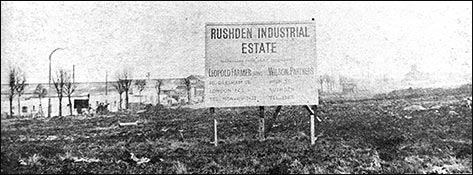 |
|
Diggers have gone and roads are laid . . . . .
|
At this stage the firm’s name or business cannot be revealed, and it is not known whether it will look for local labour or bring its own. Either way the town cannot lose.
If a certificate is granted, the factory will be built on a new 31 acre industrial development site off Wellingborough Road at Sanders Lodge.
The estate, which is being developed for roads and sewers by a London company, has been divided into 26 plots, each one covering about an acre.
Statement
In a press statement released today Mr. Julian Paine, a representative of Wilson and Partners, the Rushden estate agents acting for the developing company, said:
“Two of the plots have been earmarked by the developing company. They plan to build small warehouses and factory units on the two sites which they will lease. “The firm applying for an industrial development certificate will take on five acres. One local firm has already bought one site freehold and we have had a firm inquiry for three other plots.”
The plots can be bought freehold at a cost of between £7,500 and £6,500, or occupied on a 99 year lease, which will work out at about 10 per cent of the purchasing price per year.
The site, which should be completed within the next few days, is large enough to house several large and small industrial units, providing skilled, semi-skilled and unskilled jobs for men and women in the area.
However, firms needing industrial development certificates might find it difficult to get one for this area.
Usually certificates are granted by the Board of Trade to firms wishing to start up in the area where there is a major unemployment problem.
Miss M. J. Mutimer, manager of Rushden Employment Exchange told the “Echo” factories moving to Rushden who wanted local skilled labour might find it difficult.
But she said she would be pleased to see new industry moving to the town, particularly if it wanted unskilled male labour. At the moment she could probably fill 100 vacancies.
New industries taking up these sites should not find planning a problem. A spokesman for the county planning department said the estate had planning permission for roads and sewers and applicants for sites would have to submit factory plans for approval.
Encouraging
A spokesman for Rushden Urban Council said the council had adopted a policy of encouraging new industry to the town. It wanted to see a diversification of industry.
He said he thought the Sanders Lodge Estate was ideal for new industry and for local firms who wanted to move from more central areas.
Asked if he thought the council would be opposed to firms which would bring their own labour, the spokesman said he did not think so, particularly if it was an industry employing males.
The reasoning behind this is fairly obvious. Married men would want to bring their families with them and the wives could help off-set a labour problem in the town’s basic industry – boots and shoes,
At the moment there is no surplus of female labour in the town. If this site can be filled with suitable industries, everybody in Rushden could benefit. The ratepayer by the increase in rateable value of the land the shopkeeper by the increase of wage packets circulating throughout the town and the town as a whole by the increase in population.
But the big “if” is has Rushden left it to late, considering the almost dramatic population and industrial explosion taking place in neighbouring Wellingborough and Corby? The redevloped area
|
| Leisure Centre Plans |
|